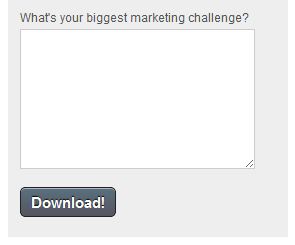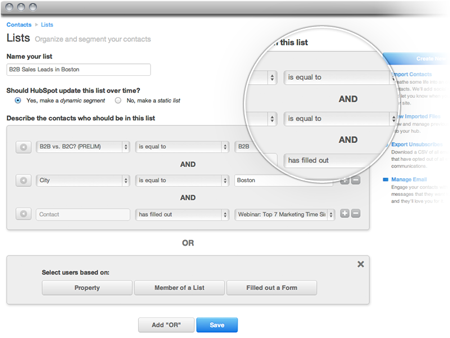

About the author: Alison Elworthy is the SVP of Customer Success at HubSpot. In this guest post, she explains how you can segment your leads and customers based on their needs and challenges. Needs segmentation helps you offer your leads the right content at the right time and increase your sales conversion rate.
There are quite a few different ways to segment and nurture your leads. And in fact, the way you choose to nurture your leads really just depends on how you decide to segment and target them.
Depending on your product or service and your marketing objectives, you can segment your leads based on demographic and geographic information or behavior-based information such as the type of content your leads have previously engaged with and which point they’re at in your funnel. These are obvious and practical ways to segment, target and nurture your leads. And from our experience here at HubSpot, we know they work.
A needs-based approach to lead segmentation and nurturing
List segmentation, however, doesn’t stop at this two-axis matrix. There’s another, less obvious way to segment and nurture leads — their needs!
Think about it. What if you knew what your visitors and leads were looking for, or even better, the problem they wanted to solve? Then you could create super tailored and customized lead nurturing for different types of leads’ needs and problems to move them more quickly through the funnel to become a paying customer. Sounds awesome, right? The problem is, it’s not as easy to figure out a prospect’s pain points as it is to figure out, say, their zip code. One could be an essay; the other is five digits. Which information do you think would be easier to capture by a form and segment with?
Okay, so therein lies the challenge. But, by knowing what your prospects want, you can easily and quickly position your product or service in a way that makes you — not your competitors — the clear and obvious solution. And there is a way marketers can do this more advanced type of nurturing. In fact, it’s critical if they really want to take their lead nurturing to the next level! And in this post, we’re going to teach you exactly how to do it through needs-based segmentation. Just follow these 4 easy steps to a better lead nurturing approach.
1) Determine your leads’ problems and needs
In order to start segmenting and nurturing your leads based on their biggest needs, pain points or challenges, you’ll need to figure out what those challenges are by collecting some data. You can do this by surveying a representative sample of your leads, or simply by adding a new field to your landing page forms. As a side note, this is a great tactic to gather information about your database — just be careful it doesn’t hurt your conversion rates on the landing page. Below is an example of a field we use on some of our own forms.

Note that, at HubSpot, we sell marketing software, so knowing our leads’ marketing challenges helps us understand what types of content to create and provide to address those needs. This field should be open-ended and tailored to your business or industry. I know, I know — it’s hard to segment based on open-ended form fields, but I’ll show you how. Trust me.
Remember that some of your leads may not even think they have an issue or problem that your product can solve. Make sure you use a broad label that covers a general industry instead of a niche one (e.g. for us, we use “marketing” instead of “marketing software”). Also, think about how you phrase “problem” or “need.” Most of your leads won’t want to admit — or even realize — they have an issue, so we use the term “challenge” instead. Once you have this field added to the forms on your landing pages, start collecting your data by promoting your landing pages and generating new leads and conversions!
2) Analyze major themes in your data, and select a handful of key needs and challenges
Once you’ve set up your landing pages and forms to collect data about your leads’ challenges, give them some time to marinate so you have a substantial data set to analyze. In order to analyze the data, you’ll need to export your form data from your marketing software or CRM — by the way, HubSpot offers an 100% free-forever CRM. If you have your data stored in a CRM, pull in other useful information to your list such as demographic or activity data on those leads that filled out the “challenge” field. This data will be useful when you start to analyze the responses in order to leverage the data in your lead nurturing.
Once you’ve exported your data, let the analytical fun begin! Unfortunately, this is a somewhat manual process since you’re collecting data on an open form field. The best way to start is to read through some of the responses to get a sense of the common themes in the challenges your leads are expressing. A quick way to get a snapshot of this is to generate a word cloud. Try uploading all the responses to Wordle, and it will spit out a visual representation of the words and phrases that are most commonly mentioned in your leads’ responses.
When you’re reviewing the responses, pick out 10-15 major themes you notice. Next, you’ll want to read through the list of responses and categorize them as best you can by those themes. Once you have all your responses categorized by theme, count the number of responses that fit into each category. As you do this, there should be a few that rise to the top of your list. When selecting your most mentioned themes, look at the data and decide on a threshold. Are there some themes that are mentioned a lot more than the rest? What sticks out? This will help you come up with your final list of lead “needs” or “challenges” that you’ll use to create a drop-down list on your forms.
3) Create and add the drop-down field to your landing page forms
Once your analysis is done and you’ve identified your top themes, it’s time to create your drop-down form field and pop it into your forms. Like any drop-down that you use in a form, you’ll want to make sure the number of options does not hinder your conversion rates. This is something you should test and iterate once you implement the new drop-down field on your forms.
Simply remove the open field you used to gather your initial set of data, and replace it with a drop-down form field based on the top themes. Your leads will now be able to select individual “challenges” or “needs” that best apply to their situation. Simple as that!
4) Segment and nurture leads by need
Once this is in place, you can start to segment your leads by need. In addition, you may want to also segment by other variables such as persona or demographic in addition to “needs” information. If you’re a B2B company, for example, a lead at a small business may have the same need as a lead from an enterprise business, but you’d probably want to craft two different messages to these two distinct groups.
With all this detailed information, you can create specific lists to nurture based on a combination of need, persona and position in the funnel. Simply pull this information from your CRM or marketing software to generate lists that fit various criteria, and import that list into your email tool. This will enable you to send content that is very targeted to your leads’ different interests and needs, improving your open and click-through rates as well as the overall effectiveness of your lead nurturing campaigns.

When you can offer your leads the right content at the right time that also addresses their most pressing challenges or needs, there’s no way you’ll miss out on future sales. Be sure to analyze the conversion rates from lead to customer before and after you implement this additional needs-based segmentation strategy. That way, you’ll have concrete stats that prove your marketing success in funneling more leads into a sales-ready state.

Online marketing best practices to drive e-commerce sales
Read our marketing guide



